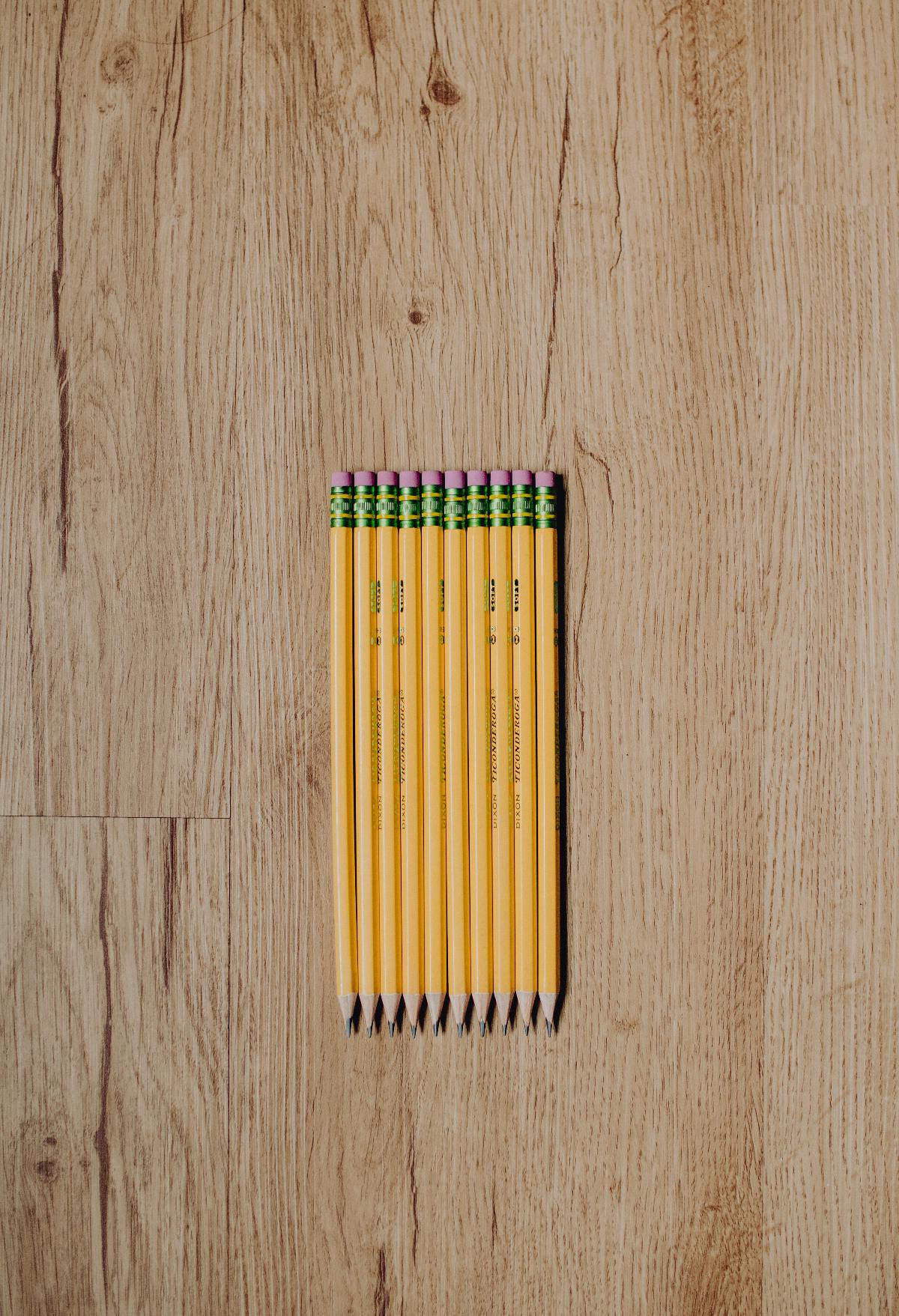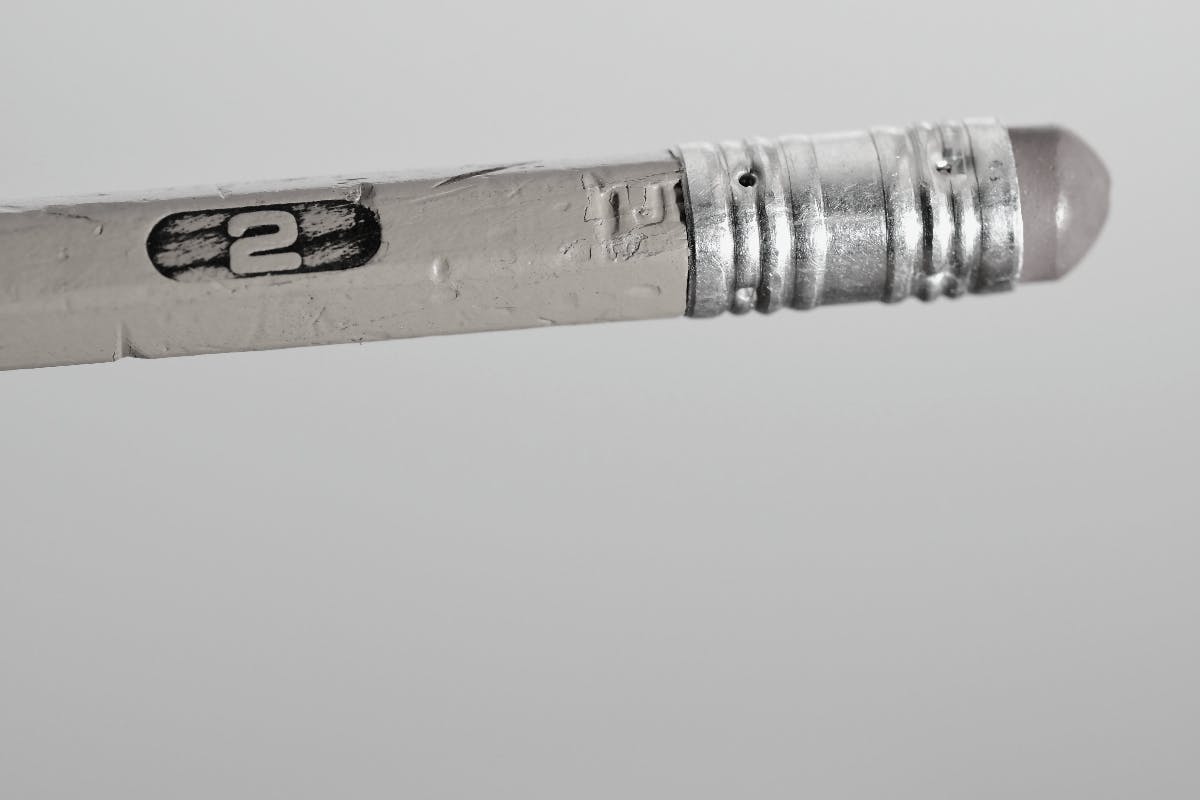
If you’re a fan of pens, pencils, and writing hand to page, if you’re of a certain age and you remember the SATs before the internet, then you’re familiar with the number, or as it is written on the side of the pencil, No. 2 pencil. Perhaps you just accepted the pencil and never questioned why or what makes a pencil a number two pencil.
A few years back, I was doing a film with the great writer/director Lawrence Kasdan. We had just shot a scene between myself and Kevin Kline, and Kasdan came into the room and said, that was good. Do you want another one? I looked at Mr. Kline, and he shook his head, and I said no. Kasdan agreed, and he turned to the crew, said moving on, and “check the gate.” There was a silence, then the camera operator, in a small, apologetic voice, said, “Uh … we don't do that anymore.” Kasdan took that information in, smiled to himself, and shouted, moving on, and we did.
Let me explain.
On a film set, when you check the gate, you literally look at the camera gate, the place where the film passes in front of the lens. That area is checked for hairs or dust, things that could scratch the film and show up in the final cut. Every set I had been on before this film, for 25 or so years, the call “checking the gate” meant the shot was done, that it was good, and we were heading into the next shot. As the shoot progressed, that phrase morphed to “chicken at eight,” “chicken in the gate,” and so on. Checking the gate was as familiar on a film set as the clapperboard.
We used a digital camera on the film I am talking about, a Red. There is no film with a digital camera, there is no gate to check, and dust or hairs can be removed in the editing. I was there when checking the gate passed into history. The new technology is excellent, but we have to let go of some things as we move on.
I thought of this story this morning when I heard the terrible news that the SAT will now be given online.
The Number 2 Pencil
If you’re a fan of pens, pencils, and writing hand to page, if you’re of a certain age and you remember the SATs before the internet, then you’re familiar with the number, or as it is written on the side of the pencil, No. 2 pencil.
Perhaps you just accepted the pencil and never questioned why or what makes a pencil a number two pencil. Maybe you’re curious, what is number 2, and what are all the Bs, Hs, and HBs added to the name of the humble pencil? It all has to do with the HB graphite grading scale used to classify the pencil’s graphite core.
The hardness of the graphite core determines a pencil's place on the graphite scale. For example, this is often written on the pencil; “2”, “2-½”, or 3. The higher the number, the harder the writing core and the lighter the mark left on the paper. The number 2 pencil is the most common in the world because it sits in the sweet spot of hardness and darkness of image on a page.
The SAT

Back in December of 1899, the College Board was established. The purpose of the Board is primarily to administer annual examinations in a variety of subjects thought to be necessary for college-level work. In 1925, the board appointed a commission to develop a new test that would measure general intelligence; Carl Brigham headed up the commission, a psychologist who helped develop aptitude tests for the U.S. Army during World War I; he was influential in the development of the 1926 test.
The test developed was called “The Scholastic Aptitude Test” or the SAT. Unlike the College Boards, the SAT is designed primarily to assess aptitude for learning rather than mastery of subjects already learned.
The test was taken using a number 2 pencil.
Pencils Down
Much like actors no longer hearing “checking the gate,” thousands upon thousands of college hopefuls will no longer hear the phrase that was both freedom and bondage, “all right, pencils down.”
We can all remember the feeling, sweat dripping down the backs of our necks, the furtive glimpses toward the clock, the quick accounting of how many questions you have left. Should you just randomly fill in the tiny ovals? Did you hear once that C is the most common answer? Should you just fill the C ovals?? Do you have enough time? Will you ever get into college? Will you be …
“Pencils down.”
And then the sound of number two pencils hitting the desks. Some, with triumphant flare, others, you could hear the hesitation, as if holding on to the pencil would allow you one more oval, one more shot at a future. That moment in time, frozen in amber, all communicated through the placing of a number 2 pencil down on a desktop.
The Scent of a Pencil
Much like the lauded film starring the great Al Pacino, the scent of a pencil lingers and arouses. It conjures memories of place and time. Don’t believe me, ask Charlie Brown as he clutched to his chest the pencil dropped by the little red-haired girl, and he marvels at the fact that she chews her pencil.
Ask Harriet, Emma’s dear friend in Jane Austen’s Emma. Harriet holds the portion of a pencil that her crush, Mr. Elton, once chewed. It is one of her dearest treasures. And something she must give to her friend and guardian, Emma, to prove she knows Mr. Elton will never be hers.
Apart from romantic connection, the scent of a pencil is a genuine, very tangible quality. The scent of pencil shavings, the leftover of what remains when a pencil gets ready in the morning, is considered one of the most loved and nostalgic smells.
The pencil as we know it today was invented in 1795 by Nicholas-Jacques Conte, a scientist serving in the army of Napoleon Bonaparte. Previously, pure carbon, what we call graphite, was wrapped in material or used on its own for mark-making.
When someone sniffs a pencil or its shavings, their minds fill with memories, and they are comforted in the warmth of a hint of cedarwood. This is because cedarwood is the primary wood used in pencils due to its ability to be sharpened without splinters. You see, a pencil loves you and would never wound you.
Pencils, like fine wines, will have hints of where they were formed. Not just the deep woody scent but also notes of mandarin, pink pepper, rose, and cypress. This leads one to ask, what’s the best pencil to go with History, Math, English Comp, or fish?
Smell is a direct route to memory, and the smell of a pencil sends us on journeys romantic, wistful, hilarious, and sweet.
A computer smells like plastic and has no warmth or connection to memory.
Collateral Damage of the Technical Age

Technology is incredible, it gives us so much, and technological advances have opened our eyes to the possibilities of the universe. But, those advances come with a price.
Just as we now watch young kids, born with smartphones in their mitts, trying to figure out how to use a dial telephone, someday we will see the number 2 pencil only in museums. Parents will regale their kids with stories of writing before the advent of the keyboard.
“Well, kids, that’s a pencil; we used to use them to write words on paper and give that paper to our teachers or friends.” Kids will then press their tiny faces against the glass and stare at the number 2 pencil, suspended on a fishing line, hanging in its spotlight, and wonder what writing without spellcheck or emojis would be like.
As they step away from the display, dad will hang back for a moment, lost in the reverie of a memory of the time when the girl, who is now the woman by his side, took his pencil from his hand mid-sentence. She said can I borrow this, and scribbled her number on a slip of paper. She handed him the paper but kept the pencil, looked over her shoulder at him, smiled, and said, if you want this back, call me. Then, maybe she bit the pencil to leave her mark, to make it unique. And he rushed home, picked up the receiver on the dial phone, and called her.
We don’t advise stealing a laptop and biting it.
Thank you, No. 2

And so, as the SATs pass from blue books, in dreadfully quiet rooms, the silence broken only by an extraordinarily loud clock, on a Saturday morning, to an online test taken at home on a computer, I ask you to pause and reflect.
A pack of pencils was always on the list of back-to-school needs.
A pencil is a primary method of communication.
A pencil was a trusted ally in the fight for higher education.
A pencil is a time machine sitting patiently in a breast pocket.
Thank you for your undying service to all the number 2 pencils I wrote with, doodled with, and scribbled notes of hope and love. You will never be forgotten, no matter how much technology tries to shove you from the spotlight. Your wood and graphite will always be worthy of my attention, welcome in my hand, and kept sharp.
It may say No. 2 on your side, but you’ll always be No.1 in my heart.

